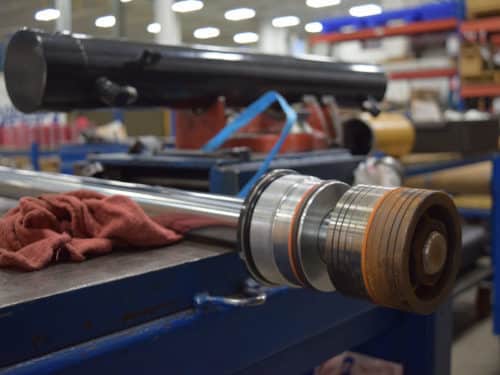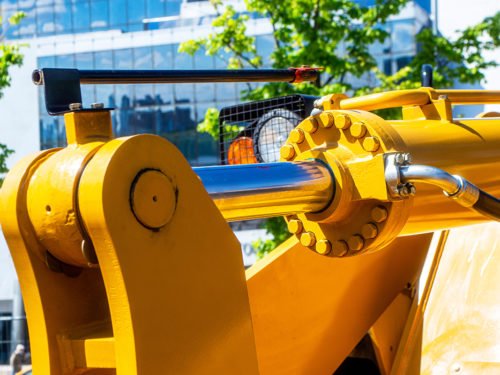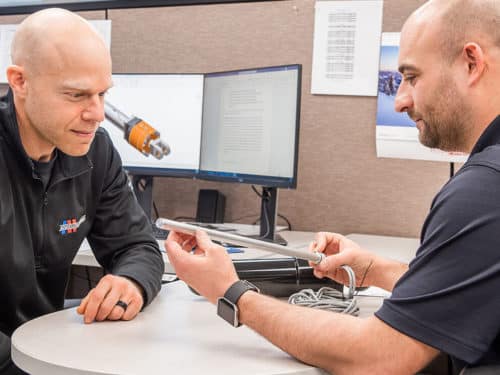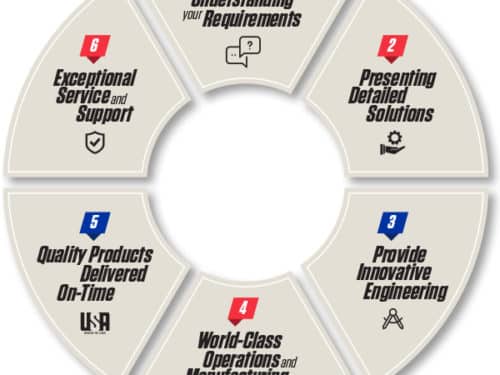Certain types of equipment require multiple cylinders to extend and retract simultaneously in a process known as synchronization. However, synchronizing cylinder movements is not always the most straightforward process. Two main methods are used to create synchronized hydraulic systems: tying the cylinders together using mechanical hardware or utilizing smart sensors to create a fully automatic position-sensing system.
What is the Purpose of Synchronizing Cylinder Movement?
Synchronized hydraulic cylinders are used to lift a load using two or more lifting points. Synchronizing cylinder movement creates accurate and precise operations at most job sites, allowing you to complete work safely. Heavier loads and equipment involving complex movements—such as agricultural seeders or plow wings— can be moved faster and more efficiently.
Synchronizing Cylinder Movement Through External Mechanical Hardware
The traditional way to synchronize hydraulic cylinders is by installing mechanical hardware. External components link the hydraulic cylinders, timing their movements to provide greater lifting capacity. Depending on the machinery, mechanically synchronized cylinders may be connected through:
- The equipment’s existing construction
- Racks and pinions
- Crankshafts
- Cables and pulleys
- Chains and sprockets
- And other methods.
While mechanical means are the most common way to synchronize hydraulic cylinder movement, they have several limitations. Most notably, when cylinders fall out of synchronization, an operator must intervene to resynchronize the actuators. This process leads to shutdowns while troubleshooting and maintenance occur, workflow disruptions, and other consequences.
Position-Sensing Cylinders Enhance Synchronized Hydraulic Systems
For applications where mechanical connections are not possible, recommended, or permitted, the best way to synchronize hydraulic cylinders is to install and use position-sensing cylinders. These high-technology options provide accurate electronic positioning feedback, allowing you to achieve consistent synchronization without operator interference. Sometimes also called “smart” cylinders, position-sensing cylinders are the ideal solution for equipment requiring synchronized movement.
Position-sensing cylinders are best utilized in markets that deal with complex equipment, such as:
- Material handling machinery
- Multi-stage agricultural equipment
- Mining applications
- Entertainment platforms
- And much more!
How to Synchronize Cylinder Movement Using Smart Sensors
Unlike systems that use mechanical ties to achieve cylinder synchronization, position-sensing cylinders use electronic feedback to tell the relevant valves when to open and close. All sensors in the system communicate with one another, and cylinders always know where they are in relation to the others. If one cylinder moves ahead, the valve will close and automatically bring it back into synchronization.
Exact operations will vary depending on the specifications and configuration of your position-sensing cylinders. For example, a system comprised of rephasing hydraulic cylinders will operate differently than a series of standard double-acting welded rod cylinders. Call 1-866-406-4100 for assistance in identifying the best hydraulic cylinders for your equipment.
The Benefits of Using Smart Sensors for Synchronizing Hydraulic Cylinders
Using sensors for synchronizing cylinder movements adds many advantages to industrial and mobile equipment. These advantages include:
- Explosion-proof and intrinsically safe cylinder constructions
- Self-correcting resynchronization minimizes shutdowns and opportunities for worker error or injury
- Ability to control the stroke of each lift point to achieve greater accuracy and timing
- All operations are monitored, managed, and controlled from a central point, allowing for real-time updates
- Precision operations streamline job sites for better output
- And many other advantages!
Contact our Sales Team today for further in-depth information about how a smart position-sensing cylinder can benefit your synchronized hydraulic system.
What are Common Concerns with Synchronizing Hydraulic Cylinders Using Sensors?
The top concern with choosing smart sensors for synchronizing hydraulic cylinders is the higher purchasing price. For OEMs and manufacturers with budget as a priority, mechanical synchronization can be tempting as these systems are cheaper to install. However, sensors more than compensate for the higher purchasing cost through reliable readings, automatic synchronization correction, and more.
Oil cleanliness is likewise a consideration for synchronizing position-sensing cylinders. Electronic connections are susceptible to corrosion, impacting the feedback of the valves, sensors, and positioning. This is particularly important when operating equipment underground, such as mining machinery. By conducting regular maintenance routines that involve checking all fluids, replacing filters, and taking other steps to prevent contamination, you can ensure your cylinders operate at a high level for a long time.
Purpose-Built™ Solutions for Synchronizing Hydraulic Cylinders
Most position-sensing cylinders will be built to your specifications, and exact capabilities will vary. For example, position-sensing cylinders from Aggressive Hydraulics feature many design advantages and Purpose-Built™ options:
- Stroke lengths to 300” (7620mm)
- Hydraulic pressure up to 5000 PSI (345 bar)
- Temperature ranges from -40°F to 221°F (-40°C to 105°C)
- Circular, Cable, or Deutsch connections
- Analog (4-20mA, 0.5-4.5Vdc, or 0-10Vdc) or digital (CAN, SSI, Ethernet) outputs
- Magnetostrictive, Hall Effect, Resistive, or Inductive sensor technology types
- IP67, IP68, or IP69K ingression protection available
No matter your needs, our engineering team will work with you to design and manufacture advanced position-sensing cylinders Purpose-Built™ to synchronize your system. Contact us or request a quote today to get started.



